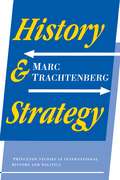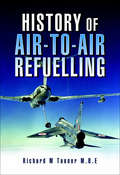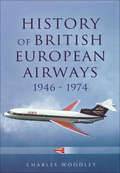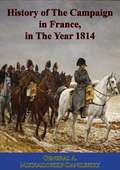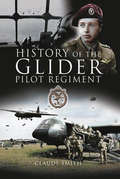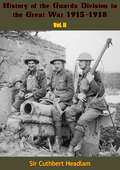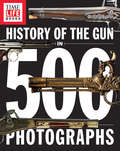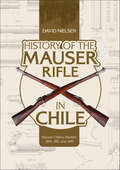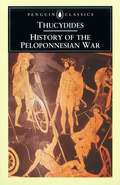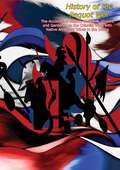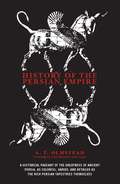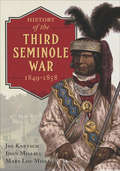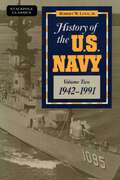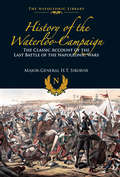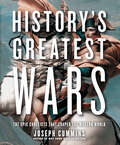- Table View
- List View
History and Strategy (Studies in Intellectual History and the History of Philosophy #1)
by Marc TrachtenbergThis work is a powerful demonstration of how historical analysis can be brought to bear on the study of strategic issues, and, conversely, how strategic thinking can help drive historical research. Based largely on newly released American archives, History and Strategy focuses on the twenty years following World War II. By bridging the sizable gap between the intellectual world of historians and that of strategists and political scientists, the essays here present a fresh and unified view of how to explore international politics in the nuclear era. The book begins with an overview of strategic thought in America from 1952 through 1966 and ends with a discussion of "making sense" of the nuclear age. Trachtenberg reevaluates the immediate causes of World War I, studies the impact of the shifting nuclear balance on American strategy in the early 1950s, examines the relationship between the nuclearization of NATO and U.S.-West European relations, and looks at the Berlin and the Cuban crises. He shows throughout that there are startling discoveries to be made about events that seem to have been thoroughly investigated.
History for the IB Diploma: Causes, Practices and Effects of Wars
by Mike WellsAn exciting new series that covers the five Paper 2 topics of the IB 20th Century World History syllabus. This coursebook covers Paper 2, Topic 1, Causes, practices and effects of wars, in the 20th Century World History syllabus for the IB History programme. It is divided into thematic sections, following the IB syllabus structure and is written in clear, accessible English. It covers the following areas for detailed study: First World War (1914-18); Second World War (1939-45); Asia and Oceania: Chinese Civil War (1927-37 and 1946-9); and Europe and Middle East: Spanish Civil War (1936-9). Tailored to the requirements and assessment objectives of the IB syllabus, it allows students to make comparisons between different regions and time periods.
History of Air-to-Air Refuelling
by Richard M. TannerThis is a unique account of the development and operational use of air-to-air flight refuelling since its early beginnings in the USA and the UK to the equipment that is in use today. The author draws upon his life-long career as senior design engineer with the successful British company In-Flight Refuelling who were responsible for the development of the hose and drogue technique now preferred by many of the world's air forces. The story begins in the early 1920s when the art of air refuelling was part of the Barn Storming record-breaking attempts that were popular in the USA. It continues into the late thirties when successful experiments were made. Amazingly, the Royal Air Force were not interested in pursuing this great technical advantage during World War II and it was the USAAF who requested the British invention to experiment with on their B–17s and B-24s. The Korean War saw extended use of operational air-to-air refuelling for the first time and now the 'tanker fleet' is an essential unit in major air-forces around the world.
History of Blood Donation and Transfusion Medicine
by Zdravko KvržićThis book offers a global overview of the history of blood donation using evidence-based research to provide accurate information on the beginnings of blood donation and transfusion medicine, developed as the result of numerous trials and successes throughout history. It leads the reader step-by-step through time, to discover how people perceived blood, and how they managed to develop new ways of treating various unfortunate conditions that shattered a person’s healthy life. This book also presents new technical discoveries that have advanced through the present day and explains how, in cases of deadly diseases, safety procedures for blood examination have been made mandatory. The conditions that led to the contamination of thousands of patients by HIV and hepatitis C around the world are explained, and the debate between voluntary and paid systems is covered as well. This book is a unique resource beneficial for everyday practice, as it encourages the reader to develop advanced practices for better and safer work with blood donors and in transfusion medicine; It gives a sense of humanitarian devotion to the deed of giving a part of yourself to save others’ lives in danger because of trauma, disease, etc., and it shares different stories of blood donors, to help patients get over their fear of donating blood. It is useful for nurses, doctors, students, blood donors, historians, and other experts!
History of British European Airways, 1946–1972: 1946 - 1972
by Charles WoodleyBEA was formed in 1946 and took over most UK domestic and European routes under the British government's nationalisation policy. It began operations with a fleet of outdated and hopelessly uneconomic passenger aircraft that were derivatives of wartime types such as the DC-3, Avro Viking and Rapide. By the end of 1955 the airline had re-equipped with more modern types such as the jet-prop Viscount and moved into a profit for the first time. From 1960 onwards the airline introduced larger jets such as the Comet, Trident and BAC 1-11. BEA merged with the British Overseas Airways Corporation in 1974 to form British Airways.This book looks at BEA's predecessors, its formation and early operation from Croydon and Northolt and the move to the newly-opened London Heathrow. The evolving structure is explained with chapters covering engineering bases, terminals, European and domestic services, cargo services and helicopter operations. The aircraft flown are all described in detail and the book includes anecdotes from former crew and ground-staff, a full fleet list and is highly illustrated throughout.
History of Men's Etiquette: A Short Guide to the Sporting Life
by Nicholas StoreyThis is Nicholas Storeys third book in the series, following History of Mens Fashion: What The Well Dressed Man Is Wearing (2008), and History of Mens Accessories: A Short Guide For Men About Town (2011) and is called History of the Sporting Life: A Short Guide to Some Sports and Pursuits For The Man of The World. This book, also with historical and social background, covers: the conduct of sporting events, including recommendations for a selection of sporting equipment, being all the necessary equipment for: shooting, fishing, hunting, tennis, badminton, squash and golf; something of members sports clubs; town and country living; town and country national and international sporting and social events and festivals; road, rail and sea travel; as well as exciting or unusual Christmas holiday destinations. In line with the first two books, this one is also packed with quirky facts and interesting digressions; including an account of the peculiar facts surrounding the last recorded civilian duel in England; a sketch of the life and death of Regency figure Robert Curricle Coates; even how to build a rose garden; to all of which is once more brought a humorous approach. World experts on the technicalities of certain topics covered have again been sought out to check over the draft to ensure that this book is not just amusing but soundly backed by authority. The book ends with an account of a memorable night spent in London.
History of The Campaign in France, in The Year 1814
by General A. Mikhailofsky-DanilefskyA fascinating account of the 1814 campaign in France which dealt the final blow to Napoleon's first reign as Emperor of the French."THE original Work, from which the present volume has been translated, was published in St. Petersburg during the latter part of the year 1836. The Author, a well-known Russian General, is now a Member of the Imperial Senate. During the eventful campaign of 1814, he served as Aide-de-camp to the Emperor Alexander, and was constantly at His Majesty's headquarters, where he was employed in wielding both the sword and the pen."-Introduction
History of the 305th Field Artillery
by Charles Wadsworth CampCharles Wadsworth Camp was a journalist, writer and foreign correspondent whose lungs were said to have been damaged by exposure to mustard gas during World War I.
History of the 508th Parachute Infantry
by William G. Lord IIThe 508th Parachute Infantry Regiment was an airborne infantry regiment of the United States Army, first formed in October 1942 during World War II at Camp Blanding, Florida by Lieutenant-Colonel Roy E. Lindquist, who would remain its commander throughout the war.The 508th Parachute Infantry Regiment participated in Operation Overlord, jumping into Normandy at 2:15 a.m. on 6 June 1944, and was awarded the Distinguished Unit Citation for its gallantry and combat action during the first three days of fighting.The Regiment also saw active service in Operation Market Garden in the Netherlands, jumping on 17 September 1944, and continued fighting the Germans in the longest-running battle on German soil ever fought by the U.S. Army, before crossing the border into Belgium.They played a major part in the Battle of the Bulge in late December 1944, during which they screened the withdrawal of some 20,000 troops from St. Vith, defended their positions against the German Panzer divisions, and participated in the assault led by the 2nd Ranger Battalion to capture (successfully) Hill 400.U.S. D-Day paratrooper William G. Lord II’s History of the 508th Parachute Infantry Regiment, which was originally published in 1948, provides an extensive and fascinating chronicle for the period from October 20, 1942 to January 1, 1946, and will appeal to discerning World War II historians and scholars alike.Richly illustrated throughout with photographs and maps, this volume also includes in its appendix a list of combat awards, unit citations, and battle casualties.
History of the Battle of Agincourt
by Harris NicolasAbout the middle of the year 1414, Henry the Fifth, influenced by the persuasions of Chicheley, Archbishop of Canterbury, by the dying injunction of his royal father not to allow the kingdom to remain long at peace, or, more probably, by those feelings of ambition which were no less natural to his youth and personal character, than consonant with the manners of the times in which he lived, resolved to assert that claim to the crown of France, which his great-grandfather, Edward the Third, urged with such confidence and success...
History of the Conquest of Mexico: With A Preliminary View Of The Ancien Mexican Civilisation, And The Life Of The Conqueror, Hernando Cortés (Modern Library Classics)
by William H. Prescott James Lockhart"It is a magnificent epic," said William H. Prescott after the publication of History of the Conquest of Mexico in 1843. Since then, his sweeping account of Cortés's subjugation of the Aztec people has endured as a landmark work of scholarship and dramatic storytelling. This pioneering study presents a compelling view of the clash of civilizations that reverberates in Latin America to this day. "Regarded simply from the standpoint of literary criticism, the Conquest of Mexico is Prescott's masterpiece," judged his biographer Harry Thurston Peck. "More than that, it is one of the most brilliant examples which the English language possesses of literary art applied to historical narration. . . . Here, as nowhere else, has Prescott succeeded in delineating character. All the chief actors of his great historic drama not only live and breathe, but they are as distinctly differentiated as they must have been in life. Cortés and his lieutenants are persons whom we actually come to know in the pages of Pres-cott. . . . Over against these brilliant figures stands the melancholy form of Montezuma, around whom, even from the first, one feels gathering the darkness of his coming fate. He reminds one of some hero of Greek tragedy, doomed to destruction and intensely conscious of it, yet striving in vain against the decree of an inexorable destiny. . . . [Prescott] transmuted the acquisitions of laborious research into an enduring monument of pure literature."
History of the Glider Pilot Regiment
by Claude SmithThe untold story of this tiny, little-known British Army regiment and the daring men who piloted engineless aircraft to WWII&’s major battlefields. The Glider Pilot Regiment, having been raised as the first element of the new Army Air Corps in 1942 and disbanded in 1957, can probably claim the dubious distinction of having been the smallest and shortest-lived regiment ever to form part of the British Army. Nevertheless, in those few years the regiment gained as much distinction as it has taken other units hundreds of years to achieve. Yet, strangely enough, the story of these heroic men who piloted their flimsy gliders to most of the important battlefields of the Second World War has never before been told. It is indeed a remarkable story, and no one is better qualified to tell it than Claude Smith, who himself served with the regiment and took part in the invasion of Normandy on D-Day, June 6, 1944, and later in the ill-fated landing at Arnhem, where he was taken prisoner. Smith tells the story of these supremely brave men factually and dispassionately, but it is impossible to read this book without being moved by their courage. As General Sir John Hackett says in his foreword: &“Those who went to battle in gliders and above all those who got them there, the Glider Pilots, deserve our enduring esteem.&” Includes maps and illustrations
History of the Guards Division in the Great War 1915-1918 Vol. I (History of the Guards Division in the Great War 1915-1918 #1)
by Sir Cuthbert HeadlamFirst published in 1924, this is Volume 1 of a two-volume set covering the history of the Guards Division during the First World War.The Guards Division was an infantry division of the British Army that was formed in the Great War in France in 1915 from battalions of the elite Guards regiments from the Regular Army.“From its formation in August, 1915, to the Armistice in November, 1918, the division served on the Western Front and took part in all the great battles of the war with the exception of that of Arras. Its troops had a great tradition to maintain and very faithfully they maintained it. To the Guards Division attached the prestige that had been so gallantly won in the first year of the war by the battalions of Guards which formed part of the original Expeditionary Force. The high standard of discipline and the devotion to duty which had characterized those splendid troops were gloriously upheld by their successors. And the loyalty, patriotism and keen esprit de corps which inspired the infantry were fully shared by the other arms of the Service belonging to the Guards Division.“The record of the Guards Division is very fully described by Colonel Headlam in the following pages. He has told his story dispassionately and without making any attempt to give undue prominence to the part played by the Guards in the Great War. He has thus succeeded, I think, in giving to those who may read his book a true picture of the life and work of the Guards Division, and has handed down to future generations of Guardsmen a record of military achievement which should be a guide and inspiration to them for all time.”
History of the Guards Division in the Great War 1915-1918 Vol. II (History of the Guards Division in the Great War 1915-1918 #2)
by Sir Cuthbert HeadlamFirst published in 1924, this is Volume 1 of a two-volume set covering the history of the Guards Division during the First World War.The Guards Division was an infantry division of the British Army that was formed in the Great War in France in 1915 from battalions of the elite Guards regiments from the Regular Army.“From its formation in August, 1915, to the Armistice in November, 1918, the division served on the Western Front and took part in all the great battles of the war with the exception of that of Arras. Its troops had a great tradition to maintain and very faithfully they maintained it. To the Guards Division attached the prestige that had been so gallantly won in the first year of the war by the battalions of Guards which formed part of the original Expeditionary Force. The high standard of discipline and the devotion to duty which had characterized those splendid troops were gloriously upheld by their successors. And the loyalty, patriotism and keen esprit de corps which inspired the infantry were fully shared by the other arms of the Service belonging to the Guards Division.“The record of the Guards Division is very fully described by Colonel Headlam in the following pages. He has told his story dispassionately and without making any attempt to give undue prominence to the part played by the Guards in the Great War. He has thus succeeded, I think, in giving to those who may read his book a true picture of the life and work of the Guards Division, and has handed down to future generations of Guardsmen a record of military achievement which should be a guide and inspiration to them for all time.”
History of the Gun in 500 Photographs
by Time-Life BooksA fascinating look into the history of the firearm and how and why it has had the impact it has on American culture and society.Few inventions have had more of a profound impact on the course of civilization than guns: The first hand-held versions were Chinese fire lances invented in the 10th century, though it was Europeans who were credited with creating the handheld weapons that we recognize today. Americans and their expansion westward were the ones who refined, and helped define innovation and the development of an industry. Starting with Samuel Colt and the ""revolver revolution,"" Americans took the lead in moving gun development forward. Names now well-known including Wesson, Winchester, and Browning helped create weapons that helped move a nation forward and ushered in the industrialized warfare of World War I. Now, TIME-LIFE, in the next book in the successful ""500 Photographs"" series, following World War II in 500 Photographs and The Civil War in 500 Photographs, brings readers the History of the Gun in 500 Photographs, which traces the fascinating evolution of firearms, not just as tools of security, but as ingenious feats of science and engineering. This book contains over 500 photos that take readers on a historical and visual journey of the gun, not just as a weapon, but as a constantly-evolving artifact that has shaped America's culture and mindset.
History of the Mauser Rifle in Chile: Mauser Chileno Modelo 1895, 1912, and 1935
by David NielsenThe acquisition history and the technical specifics of the Mauser rifles and carbines sold to Chile from 1895 to 1935
History of the Peloponnesian War
by Thucydides'With icy remorselessness, it puts paid to any notion that the horrors of modern history might be an aberration - for it tells of universal war, of terrorism, revolution and genocide' Tom HollandThe long life-and-death struggle between Athens and Sparta plunged the ancient Greek world into decades of war. Thucydides was an Athenian and achieved the rank of general in the earlier stages of the war, and in this detailed, first-hand contemporary account he writes as both a soldier and a historian. He applies a passion for accuracy and a contempt for myth and romance in compiling a factual record of a ruinous conflict that would eventually destroy the Athenian empire.Translated by Rex Warner with an introduction and notes by M. I. Finley
History of the Pequot War: The Accounts Of Mason, Underhill, Vincent And Gardener On The Colonist Wars With Native American Tribes In The 1600s
by Charles OrrStep back into the tumultuous early days of American colonial history with Charles Orr's History of the Pequot War: The Accounts of Mason, Underhill, Vincent, and Gardener on the Colonist Wars with Native American Tribes in the 1600s. This compelling compilation offers an unparalleled window into the Pequot War, a brutal and decisive conflict that shaped the future interactions between European settlers and Native American tribes.Orr meticulously gathers and presents the firsthand accounts of four key figures: John Mason, John Underhill, Philip Vincent, and Lion Gardener. Their narratives provide a comprehensive and multifaceted view of the events, strategies, and personal experiences during the Pequot War. Through their eyes, readers gain insight into the motivations, challenges, and brutal realities faced by both the colonists and the Pequot people.The book delves into the origins of the conflict, exploring the cultural tensions, economic pressures, and territorial disputes that led to the outbreak of war. It vividly recounts significant battles, such as the Mystic Massacre, and examines the tactics and decisions that ultimately led to the near-destruction of the Pequot tribe. Orr's compilation not only captures the military aspects of the war but also provides context to the broader impact on colonial and Native American relations.Join Charles Orr in exploring this critical chapter in American history, and gain a deeper appreciation for the resilience, conflict, and transformation that defined the Pequot War. This book is a must-read for anyone seeking to comprehend the profound and lasting consequences of early colonial warfare on the shaping of the New World.
History of the Persian Empire
by A. T. Olmstead“The fullest and most reliable presentation of the history of the Persian Empire in existence.” —M. RostovtzeffAt the foot of the Mount of Mercy in southeastern Persia, Darius the Great built his capital, Persepolis—symbol of Persian glory for two centuries. At its height the Achaemenid Empire, with its power centered in this city, reached from the Nile and Greece eastward to India. Dominating the major travel routes between East and West, it was the meeting ground of the great cultures of the ancient world.Here is the history of the crucial period from Cyrus’ extension of Persian rule to Greece to the burning of Persepolis itself by Alexander the Great. Out of a lifetime of study of the ancient Near East, Professor Olmstead has gathered previous unknown material into the story of the life, times, and thought of the Persians told for the first time from the Persian rather than the traditional Greek point of view. In this story, the author shows how the science, literature, language, and myths of the ancients grew from the intermingling of many cultures and entered into the formation of our own civilization.
History of the Russian Revolution
by Leon Trotsky Max EastmanLeon Trotsky is considered by many, alongside Lenin of course, as the author of the Russian Revolution, and is also considered by his admirers to be one of the most astute Marxist analysts of history and politics. It is perhaps no surprise therefore that his history of the Russian Revolution, first published in English in 1932, should be considered by those admirers to be his masterpiece, with Afro-Trindidadian writer C.L.R. James, once calling it "the greatest history of an event that I know." Trotsky's narrative of the revolution is told in the third person and is not a memoir. Annotation ©2008 Book News, Inc., Portland, OR (booknews.com)
History of the Third Seminole War, 1849–1858: 1849-1858
by Joe Knetsch John Missall Mary Lou MissallThis definitive account of the final war between the US government and Florida&’s Seminole tribe &“brings to life a conflict that is largely ignored&” (San Francisco Book Review). Spanning a period of over forty years (1817–1858), the three Seminole Wars were America&’s longest, costliest, and deadliest Indian wars, surpassing the more famous ones fought in the West. After an uneasy peace following the conclusion of the second Seminole War in 1842, a series of hostile events, followed by a string of murders in 1849 and 1850, made confrontation inevitable. The war was also known as the &“Billy Bowlegs War&” because Billy Bowlegs, Holata Micco, was the central Seminole leader in this the last Indian war to be fought east of the Mississippi River. Pushed by increasing encroachment into their territory, he led a raid near Fort Myers. A series of violent skirmishes ensued. The vastness of the Floridian wilderness and the difficulties of the terrain and climate caused problems for the army, but they had learned lessons from the second war, and, amongst other new tactics, employed greater use of boats, eventually securing victory by cutting off food supplies.History of the Third Seminole War is a detailed narrative of the war and its causes, containing numerous firsthand accounts from participants in the conflict, derived from virtually all the available primary sources, collected over many years. &“Any reader interested in learning more about Indian wars, Army history, or Florida history will profit from reading this book,&” as well as Civil War enthusiasts, since many of the officers earned their stripes in the earlier conflict (The Journal of America&’s Military Past).
History of the U.S. Navy (Stackpole Classics)
by Robert W. LoveThis sweeping recasting of American naval history is a bold departure from the conventional &“sea power&” approach. Volume Two of History of the U.S. Navy shows how the Navy in World War II helped to upset the traditional balance in Europe and Asia. Days after Pearl Harbor, Admiral Ernest J. King took command of a navy overwhelmed by the demands of war. King devised grand strategies to defeat the Axis and promoted a cadre of fighting admirals—Halsey, Spruance, Hewitt, Kincaid, and Turner—who waged unprecedented in complexity and violence. New sources provide an entirely fresh look at the Battle of the Atlantic, the invasion of Europe, and the great naval campaigns in the Pacific.This book contains the first comprehensive interpretation of the U.S. Navy&’s role in the Cold War, when the United States found itself the global bailiff. Love demonstrated that the Navy&’s abiding priority was to capture and maintain a share of the strategic bombardment mission by building new ships, planes, submarines, and mission to deliver nuclear weapons.The dawn of the New World Oder found the Navy still on duty as the mailed fist of American foreign policy, standing watch in the Persian Gulf and, at the same time, off the coast of West Africa during Liberia&’s violent civil war. Fresh challenges, the author argues, call for a newly balanced fleet and continued attention to America&’s first line of defense.
History of the U.S. Navy (Stackpole Classics)
by Robert W. LoveThis is the exciting story of the American Navy and its important role in our nation&’s history from the Revolutionary War to the dawn of the New World Order. Presented in two volumes, Robert Love shows how the interplay of international affairs, foreign policy, partisan politics, changing technology, and Navy views has shaped the American fleet and continues to define its missions and operations.
History of the Waterloo Campaign: The Classic Account of the Last Battle of the Napoleonic Wars (The Napoleonic Library)
by H.T. SiborneCaptain William Siborne became an ensign in the 9th Foot in 1813 and was sent to France in 1815 as part of a battalion despatched to reinforce Wellingtons army. A notable topographer, after the events that year he was commissioned to create a scale model of the Battle of Waterloo, for which he carried out extensive research, writing to officers in the allied forces present to obtain information. The subsequent correspondence amounted to the largest single collection of primary source material on the subject ever assembled. After he had completed his model, which is today on public display in the National Army Museum in London, he used the mass of information he had gathered to produce his History of the Waterloo Campaign, which was at the time the most detailed account of the operations of 1815 and is still considered a classic work on the subject.Sibornes history of Waterloo, the latest addition to Frontline's growing Napoleonic Library, is essential and gripping reading for all those who are interested in how this famous battle was fought and won.
History's Greatest Wars: The Epic Conflicts That Shaped the Modern World
by Joseph CumminsA centuries-spanning study of twenty-five pivotal wars that shaped world history, from the Greco-Persian War to the Soviet-Afghan War.Driving and dispersing peoples across the globe, giving birth to and destroying great empires, transforming cultures, and determining systems of government, warfare, as much as anything else, has fashioned our world.History’s Greatest Wars: The Epic Conflicts that Shaped Our Modern World highlights pivotal victories that changed nations, even entire continents, forever, and charts the astonishingly rapid evolution of warfare. It delineates defining moments in the development of political philosophies, as well as the scientific innovations that yielded the machine gun, the tank, and the atom bomb.From the Greco-Persian Wars that began in 500 BCE, to the Vietnam War and beyond, it vividly renders the key victories that turned the tide of war, and recounts the heroism of armies and individuals. Yet it does not shy away from showing the acts of savagery that characterize much warfare: the slaughters and massacres. History’s Greatest Wars covers twenty-five of the most important and “thunderous” wars, wars that shook the world and took part in forming the nations that, today, we call home.The best and worst of humanity is on display here, in a collection that will act as a perfect primer for novices while offering seasoned history readers new perspectives on many famous and some not-so-well-known conflicts. Sweeping in its scope, yet intimate in its insights into the motivations of politicians, strategists, commanders, and soldiers, this is a collection that will enhance your understanding of the modern world and your own place in it.
